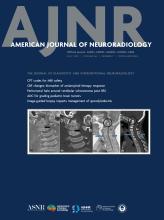Case of the Month
Section Editor: Nicholas Stence, MD
Children's Hospital Colorado, Aurora, CO
April 2022
Next Case of the Month Coming May 10...
Primary Glioblastoma
- Background:
- This case illustrates the work-up of multifocal hemorrhagic mass lesions. The patient underwent right parietal craniotomy for resection of the mass lesions. Excisional biopsy results confirmed primary glioblastoma, WHO grade IV, IDH wild-type. The case is atypical because of the rare age and imaging presentation of a primary brain malignancy.
- Glioblastoma (GBM) is another term for WHO grade IV astrocytoma according to the revised WHO 2016 criteria. The primary division is based on whether the tumor is thought to arise de novo (primary) or from another source (secondary). IDH gene mutations are associated with improved survival, but predominantly found in secondary GBM.
- GBM is the most common primary intracranial neoplasm in adults, occurring predominantly after the age of 40 years with peak incidence in the 60s–70s.
- Primary GBM is much less common in children and accounts for only approximately 5% of all pediatric CNS tumors. There is a slight male predominance.
- Clinical Presentation:
- There is a spectrum of initial presenting symptoms based on tumor location.
- Common presenting symptoms include focal neurologic deficits, mental status changes, and seizures.
- Typically, patients present with symptom onset in less than 3 months.
- Key Diagnostic Features:
- The supratentorial white matter is the most common location. Multifocal disease is rare and only seen in approximately 5–20% of cases.
- Classic CT findings include large masses that are iso- or mildly hyperattenuating. There is typically mass effect, surrounding vasogenic edema, and thick/irregular/heterogeneous peripheral enhancement.
- Glioblastomas may also have a necrotic core or hemorrhagic component. GBM is also known to cross the corpus callosum and/or the commissures to involve the contralateral hemisphere.
- Contrast-enhanced MRI is considered the most sensitive imaging modality.
- Advanced MRI techniques, including perfusion imaging (PWI), MRS, and DWI, allow for enhanced surgical and radiotherapy treatment planning.
- Differential Diagnoses:
- Hemorrhagic metastatic disease: For example, from melanoma, testicular choriocarcinoma, or a primary thyroid malignancy. Cerebral metastases are usually centered at the gray-white matter junction with associated edema. CT CAP, US thyroid, and US scrotum were negative, so occult primary was considered less likely.
- Multifocal abscess: Usually demonstrates peripheral enhancement and central restricted diffusion. The patient was also afebrile with normal labs at presentation. Additional infectious/inflammatory work-up was within normal limits.
- Lymphoma: Should be highly considered in immunocompromised patients. Classically hyperdense masses on CT that demonstrate homogeneous enhancement. Corpus callosum involvement can be seen. Ring enhancement may be seen in immunosuppressed patients.
- Treatment:
- Independent predictors of longer patient survival include age <45 years, extent of resection, and MGMT methylation status. MGMT promoter hypermethylation improves prognosis by increasing sensitivity to alkylating agents.
- Predictive response markers can substantially improve clinical outcomes in patients with high-grade gliomas. For example, 1p/19q codeletion is associated with improved response to chemotherapy.
- Excisional biopsy and surgical debulking/removal are the most common initial treatments. Postoperative adjuvant chemoradiation is secondary.
- MRI is utilized for close monitoring for residual or recurrent tumor.











